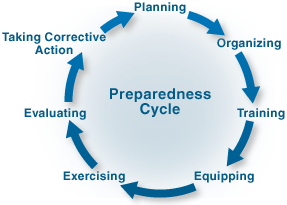
Preparedness |
|||
Preparedness is achieved and maintained through a continuous cycle of planning, organizing, training, equipping, exercising, evaluating, and taking corrective action. Ongoing preparedness efforts among all those involved in emergency management and incident response activities ensure coordination during times of crisis. Moreover, preparedness facilitates efficient and effective emergency management and incident response activities. This component describes specific measures and capabilities that emergency management/response personnel and their affiliated organizations should develop and incorporate into their overall preparedness programs to enhance the operational preparedness necessary for all-hazards emergency management and incident response activities. In developing, refining, and expanding preparedness programs and activities within their jurisdictions and/or organizations, emergency management/response personnel should leverage existing preparedness efforts and collaborative relationships to the greatest extent possible. Personal preparedness, while an important element of homeland security, is distinct from the operational preparedness of our Nation’s emergency management and incident response capabilities and is beyond the scope of NIMS. Mutual Aid Agreements and Assistance Agreements Mutual aid agreements and assistance agreements are agreements between agencies, organizations, and jurisdictions that provide a mechanism to quickly obtain emergency assistance in the form of personnel, equipment, materials, and other associated services. The primary objective is to facilitate rapid, short-term deployment of emergency support prior to, during, and after an incident.NEMA/EMAC Emergency Management Assistance Compact (EMAC) Model Intrastate Mutual Aid Legislation Model State-County Mutual Aid Deployment Contract Cooperative Agreements Model Mutual Aid Agreements Personnel with roles in emergency management and incident response at all levels of government—including persons with leadership positions, such as elected and appointed officials—should be appropriately trained to improve all-hazards capabilities nationwide. Additionally, nongovernmental organizations and private-sector entities with direct roles in response operations should be strongly encouraged to participate in NIMS training and exercises. Standardized NIMS training courses focused on the structure and operational coordination processes and systems, together with courses focused on discipline-specific and agency-specific expertise, help to ensure that emergency management/response personnel can function together effectively during an incident. Training and exercises should be specifically tailored to the responsibilities of the personnel involved in incident management. Mentoring or shadowing opportunities, to allow less experienced personnel to observe those with more experience during an actual incident, should be incorporated to enhance training and exercising. Additionally, exercises should be designed to allow personnel to simulate multiple command, supervisory, or leadership roles whenever possible. The Homeland Security Exercise and Evaluation Program (HSEEP) is a capabilities- and performance-based exercise program that provides a standardized policy, methodology, and language for designing, developing, conducting, and evaluating all exercises. HSEEP also facilitates the creation of self-sustaining, capabilities-based exercise programs by providing tools and resources such as policy and guidance, training, technology, and direct exercise support. This blended approach to HSEEP implementation promotes exercise expertise, while advancing a standardized means of assessing and improving preparedness across the Nation. HSEEP provides common processes, consistent terminology, tools, and policies that are practical and flexible for all exercise planners. The HSEEP volumes deliver exercise program guidelines that capture lessons learned and best practices of existing exercise approaches, while suggesting strategies that align exercise programs within a broader spectrum of preparedness activities, such as training, planning, and equipment purchases. The HSEEP approach can be adapted to a variety of scenarios and events. Q. What role does Preparedness have in NIMS?
Q: NIMS promotes the use of State and local mutual aid to help local jurisdictions better handle large-scale disasters. Where can I find information on how to write a mutual aid agreement?
Q: How does the NIC view its role in the management of mutual aid resources? Is there potential for conflict between the NIC and EMAC?
2006:
|
|||

 Email Updates
Email Updates NIMS provides the mechanisms for emergency management/response personnel and their affiliated organizations to work collectively by offering a consistent and common approach to preparedness.
NIMS provides the mechanisms for emergency management/response personnel and their affiliated organizations to work collectively by offering a consistent and common approach to preparedness.